|
Black mamba
Length: Maximum 4m, average
3m.
Lifespan: Up to 12 years
in captivity.
Food: Lizards, birds,
rodents and other small mammals.
Distribution: Eastern
Africa, from southern Ethiopia to southwest Africa.
Status: At present not
endangered. Increasing human disturbance could cause a threat in the future.
After the king cobra,
the black mamba is the longest venomous snake in the world. It is also the fastest-moving snake in the world, reaching up
to 23km/h. In spite of its name, the snake tends to be greyish-brown in colour.
Black Mamba Habits
Black mambas spend their
nights in holes in the ground - usually disused burrows - or hiding deep among fallen rocks or timber. These hiding places
are also fled to by the snake if it becomes alarmed and it will attack any creature blocking the path to its hole.
Like all reptiles, the
black mamba is cold blooded, and relies on external heat to maintain its body temperature. Therefore, it frequently basks
in the sun during the day, either on a low branch or a rock, but during the summer, the snake may be forced to take cover
in its burrow if it becomes too hot.
Food and hunting: Black
mambas travel quickly across rough ground or along low tree branches when hunting. They are able to hold their heads up to
1m above the ground when striking, and can hold them 50cm above the ground even when moving. They have very good eyesight
and can strike their prey - rodents, bats, birds and lizards like lightning, leaving their powerful venom to finish off the
kill.
The venom is injected
through two hollow fangs at the front of its mouth which lie flat until the snake bites something, at which point small, movable
mouth bones erect them. The venom causes rapid paralysis. Enzymes in the snake’s saliva start to digest the prey before it
even reaches the stomach, and most prey is digested within a few hours.
Breeding: This takes
place in spring and early summer. Males may travel long distances looking for females. After mating, the snakes return to
their own holes. Females lay between 10 and 25 eggs, usually in decaying vegetation. The decomposition of the vegetation gives
off heat, which helps to warm the eggs and speed up hatching time. The shells of the eggs allow water and oxygen to reach
the developing embryos.
Black mamba hatchlings
are around 51cm long, and greyish-green in colour. They are independent immediately and can catch prey the size of a small
rat. Within a year, they reach 2m. Young mambas are eaten by mongooses, and even adult mambas are eaten by the secretary bird
and larger species of eagle.
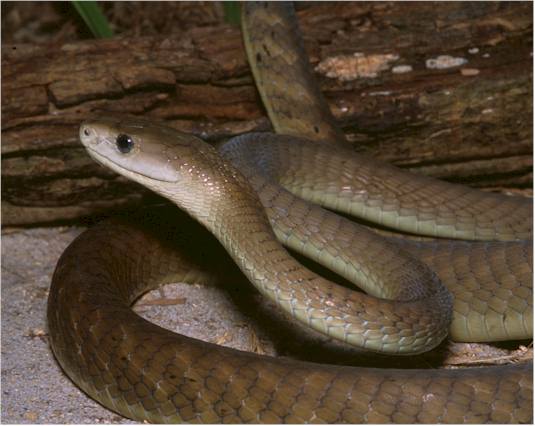
GREEN MAMBA
SCIENTIFIC NAME:Dendroaspis
angusticeps
PHYLUM: Chordata
CLASS: Reptilia
ORDER: Squamata
FAMILY: Elapidae
LENGTH: 4-7 feet
RANGE: Most of East Africa;
from Kenya
to Zimbabwe.
HABITAT: Found usually
in tropical or wooded areas. Mambas are also very good tree climbers.
DIET: Feeds mostly on
birds and lizards. The mamba differs from other snakes in that after striking its prey it leaves it to die. Digestion of a
kill requires eight to ten hours.
LOCATION IN THE ZOO: Herpetarium
ANATOMY
Mambas have scales on
their bodies. The green in the mamba's body is used to help hide it from its enemies while resting in the trees. The mamba's
jaw is adapted for feeding, with the snake's skin being elastic and it being able to dislocate. That is why the mamba can
swallow prey up to four times the size of its head.
SENSES
Smell is detected by
the use of mamba's tongue, which picks up vibrations.
Vibrations can also be
picked up from the ground through the mamba's body.
LOCOMOTION
When confronted by predators,
mambas prefer to flee at speeds up to 7 mph, but will strike when threatened.
HABITS
Non-territorial.
Mambas rely on abandoned
termite mounds and animal holes for shelter.
Other areas include sparse
brush and rocky areas.
ACTIVITY PERIOD
Usually diurnal, except
in areas where populations are large,
where they have become
somewhat nocturnal.
ENEMIES
Enemies are larger animals
and humans.
DEFENSE
Usually will flee, but
if cornered or trapped, mambas will hiss and/or strike out to defend themselves. When striking out, if hit the green mamba
injects a whitish venon which affects the victim's nervous system; it mostly affects the heart or breathing.
SOCIAL UNIT
The green mamba travels
throughout its life alone.
REPRODUCTION
Mating occurs in spring
after the male finds a female from her scent trail.
Copulation can be drawn
out to over a couple hours or days. After copulation the female can lay from 10-15 eggs. The eggs are long and thin and range
4-6 centimeters in length and 3-3.5 centimeters in width.

Shield Nose snake
Aspidelaps scutatus scutatus
Southern Africa
Length:
Average: 0.4 - 0.75m
Activity:
Nocturnal
Diet:
Small mammals, amphibians,
lizards and other snakes
Danger Rating:
Young:
Eggs: 4 - 10
...........
Dwarf adder
The Namaqua dwarf adder
is the shortest venomous snake in the world, reaching a maximum length of just 28 cm. All members of the family Viperidae,
containing the vipers and pit vipers, have broad triangular shaped heads and heavy bodies that feature many scales. They have
long hinged fangs that allow them to inject prey into their victims; when not in use, these fangs fold back and rest against
the roof of the mouth. Between each nostril and eye there is a pit containing heat-sensitive organs, which allow the snake
to detect prey.
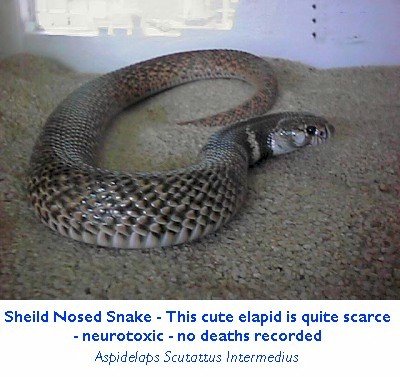
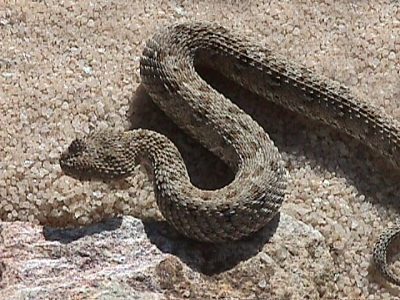
Cape cobra
Name: Naja nivea
Length: Average 1,2m Maximum 2m
Active: Nocturnal and diurnal
Dwelling: Ground, shrubs and trees
Body colour variable,
from black to brown, orange, yellow or mottled.
Stands its ground and
spreads a broad hood when confronted.
Active during the day
and early evening.
Preferred habitat
Fynbos, Karoo,
arid savanna where it inhabits rodent burrows, disused termite mounds and rock crevices.
Frequently found near
human dwellings. It well readily enter a house to escape from the heat.
Cape Cobra ready to strike
Habits
Active during the day
and early evenings when it might even climb trees to search for food.
When confronted this
nervous snake invariably faces its enemy, spreading a broad, impressive hood.
It strikes readily, except
if the attacker remains motionless - then it will soon move off.
Danger to man
An extremely dangerous
cobra that stands it ground if confronted. Bites are common and often fatal,
the victim dying of suffocation.
Venom
A highly neurotoxic venom,
most potent of any Africa cobra.
Food and feeding
The Cape Cobra feeds on rodents, birds, other snakes,
lizards and toads.
It will even climb into
a tree to reach fledgling birds in their nests. It will also raid sociable weavers'
nest.
It will frequent human
dwellings to find shelter and look for mice.
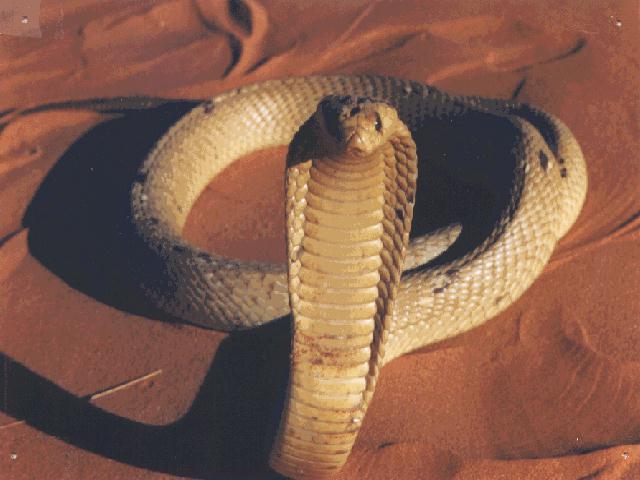

Spitting cobra
Name: Hemachatus haemachatus
Length: Average 1m Maximum 1,5m
Active: Nocturnal and diurnal
Dwelling: Ground
Banded snake
Lifts up to half its
body off the ground and spreads a hood.
Basks in the sun
Plays dead when approached
Preferred habitat
Grassland , moist savanna,
lowland forest and fynbos. It is often encountered on smallholdings in and around
cities in the area of dams, compost heaps and rockeries.
Habits
It is mainly active at
night, but likes to bask in the sun. If cornered it will lift up to half its
body from the ground and spread its hood.
It can spit effectively
for up to three metres. Sometimes the Rinkhals will play dead, hang limply, but
it can strike at any time.
Bites are rate and are
more inflicted on dogs and horses.
Danger to man
Its venom is potentially
deadly, but fatalities are rare.
Venom
A dangerous neurotoxic
venom that affects breathing and may cause respiratory failure in untreated cases.
Food and feeding
The Rinkhals hunts mainly
at night. It is very partial to toads.
It also feeds on lizards,
rodents, snakes, birds and their eggs. The eggs are swallowed whole.
Development is this snake's
biggest enemy as more and more of its habitat is destroyed.
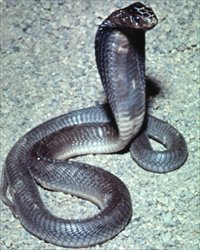
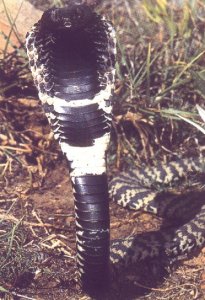
Gaboon Viper
The West African Gaboon
Viper is the largest of the Old World vipers. Though their length tops
out at about 7 feet, they are thick-bodied and may weigh up to 25 lbs. On the
largest examples, the head can be nearly six inches across its widest ,point. When
observed against a neutral background, Gaboon vipers ar gaudily marked with diamonds and stripes against a light buff-to-pink
background. This striking pattern is excellent camouflage in the snake's native
forest habitat, however, blending into the leaf litter. The head mimics a fallen leaf. These two images show closeups
of the pattern, and of the head, displaying the scaly "horn" that gives this snake its subspecies name:
Gaboon vipers are passive
hunters, waiting concealed to strike at whatever
small creatures pass
within range. They have the longest fangs of any
snake, reaching 2 inches
in a large specimen. Most snakes strike and
release, but the gaboon
viper holds its prey until the victim dies. Due
to the snake's placid
nature, bites to humans are rare; most occur when the
snake is stepped on before
it has an opportunity to get away. If
harassed, it will raise
the upper part of its body and hiss in threat
before actually striking. In addition to its unwillingness to bite, the
viper can control whether
and how much venom is injected, so the result of
a strike can range from
no effect to rapid death. A hungry snake will
strike at almost any
lateral movement, so some bites might well be a
result of mistaken identity.
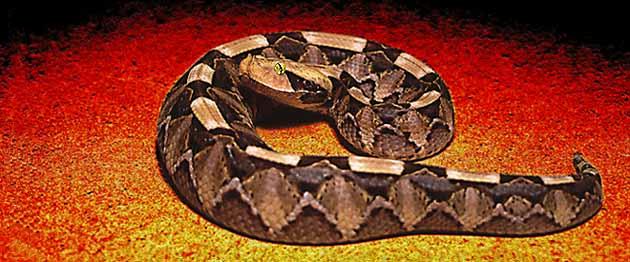
Many horned adder
Name: Bitis cornuta
Length: Average 30cm Maximum 61cm
Active: Nocturnal and diurnal
Dwelling: Ground
A tuft of 2-4 horns above
each eye.
Often seen crossing roads
after sunset.
Prefers gravel flats
where it can shelter from the wind.
Most active at dusk and
in the early mornings.
Preferred habitat
Found on mountains, rocky
outcrops and gravel plain in dry areas and savanna.
Habits
It prefers rocky areas
on sandy or gravel flats. It is most active at dusk or early mornings. When confronted it will hiss and strike with force.
Note the tufts of horns
above each eye.
Danger to man
This snake's venom yield
is minute.
It poses no great threat
to man, but it has an extremely painful bite.
Venom
Mildly cytotoxic with
much pain and swelling.
Food and feeding
The many-horned adder
mainly feeds on ground-living lizards, small rodents and amphibians.
Many individuals are
captured for the exotic pet trade and exported illegally.
They are also often killed
by passing vehicles when they are crossing the roads.
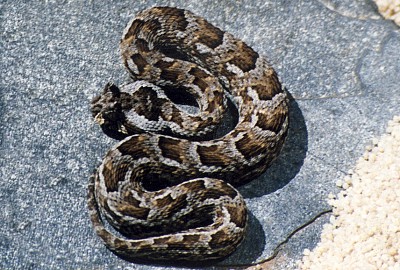
Berg adder
Name: Bitis atropos
Length: Average 30cm Maximum 60cm
Active: Diurnal
Dwelling: Ground
A triangular head.
Lacks chevron markings
along the body.
Hisses loudly.
Strikes readily if disturbed
It likes to bask in the
sun.
Preferred habitat
Montane grassland, fynbos
and rocky slopes .
Habits
A particularly bad-tempered
snake that hisses loudly and will strike readily if approached.
A Berg adder sunning
itself on a rock.
Danger to man
Berg adders are common
and strike readily when encountered.
Venom
The venom differs from
that of most adder in that it is mildly neurotoxic, with specific action on the optic and facial nerves, causing drooping
eyelids, dizziness and temporary loss of smell and taste.
Food and feeding
It feeds mainly on lizards
and small rodents but also amphibians, including rain frogs.
Nestlings of ground-living
birds and smaller snakes are also taken. Juveniles, however, feed largely on
frogs and other amphibians. Its enemies are mainly predatory birds and other
snakes.
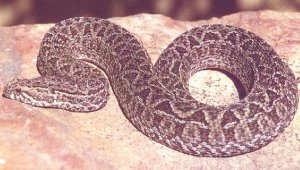
Horned adder
Name: Bitis caudalis
Length: Average 25cm Maximum 50cm
Active: Nocturnal and diurnal
Dwelling: Ground
A small adder with a
triangular head distinct from the rest of the body.
A single horn above each
eye.
Hisses and strikes readily.
May worm itself into
loose sand.
Preferred habitat
Dry, sandy regions in
arid savanna and semi-desert areas.
Habits
A small adder that may
bury itself in loose sand by wriggling until concealed. Only the top of the head,
eyes and the little horns are left exposed.
The horned adder may
bury itself in the sand
Danger to man
May inflict a painful
bite which causes swelling but poses no real threat.
Venom
The venom is mildly cytotoxic
causing swelling and much pain, accompanied by shock and local necrosis.
Food and feeding
Feeds on small lizards
such as skinks, which it ambushes in the day or geckos and rodents at night. Amphibians
are also taken. It uses the darkened tip of its tail to lure pray when it is
buried in loose sand. When it strikes it hangs onto its prey while its venom
takes effect.
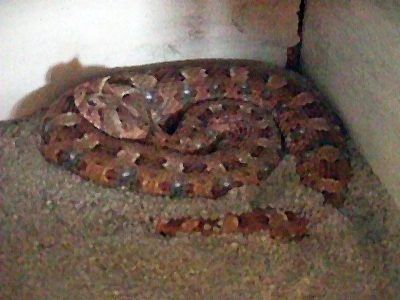
Coral snake
Name: Aspidelaps lubricus
Length: Average 40cm Maximum 80cm
Active: Nocturnal
Dwelling: Ground
It has several black
crossbars down the length of its body.
Lifts its head off the
ground and spreads a narrow hood.
Strikes repeatedly while
hissing and lunging forward.
Active at night.
Preferred habitat
Rocky outcrops, stony
and dry, sandy regions such as desert, arid savanna, Karoo and fynbos.
Habits
Spend most of its life
underground, emerging at night to forage for food.
Very active after rains.
The Coral snake emerges
mainly at night
Danger to man
Bites have not resulted
in life-threatening symptoms.
Venom
Very little is known
about its venom.
Food and feeding
The Coral snake feeds
mainly on lizards, small snakes and rodents.
Many of these snakes
are killed on roads just after good rains because then they become much more active.
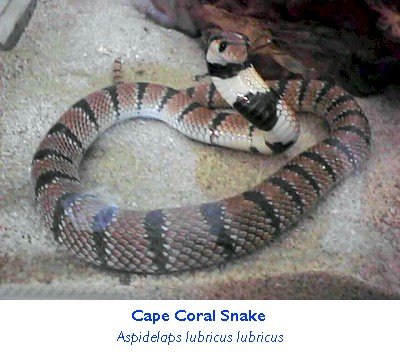
|

